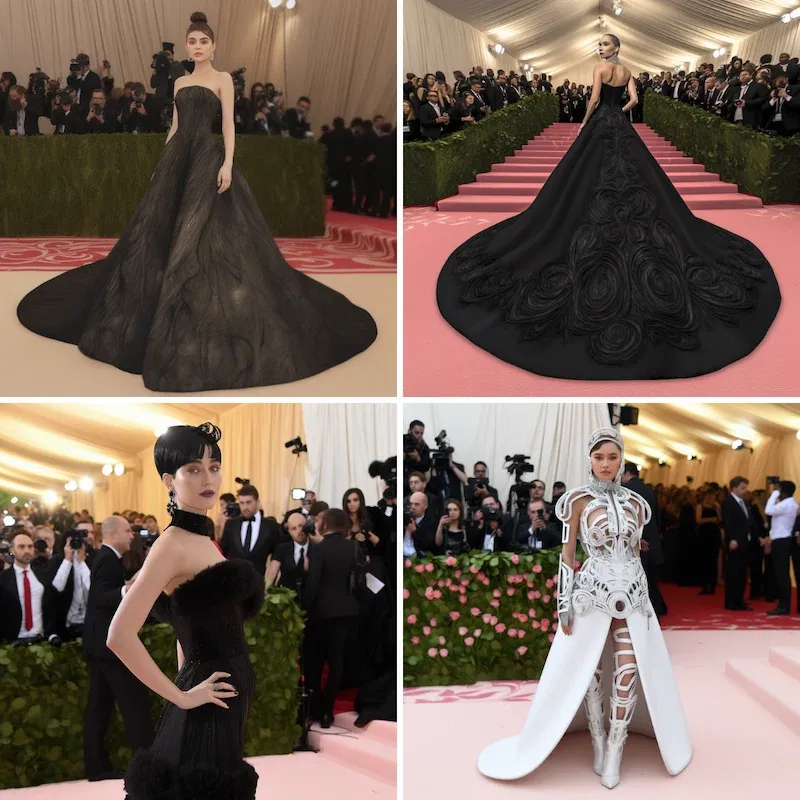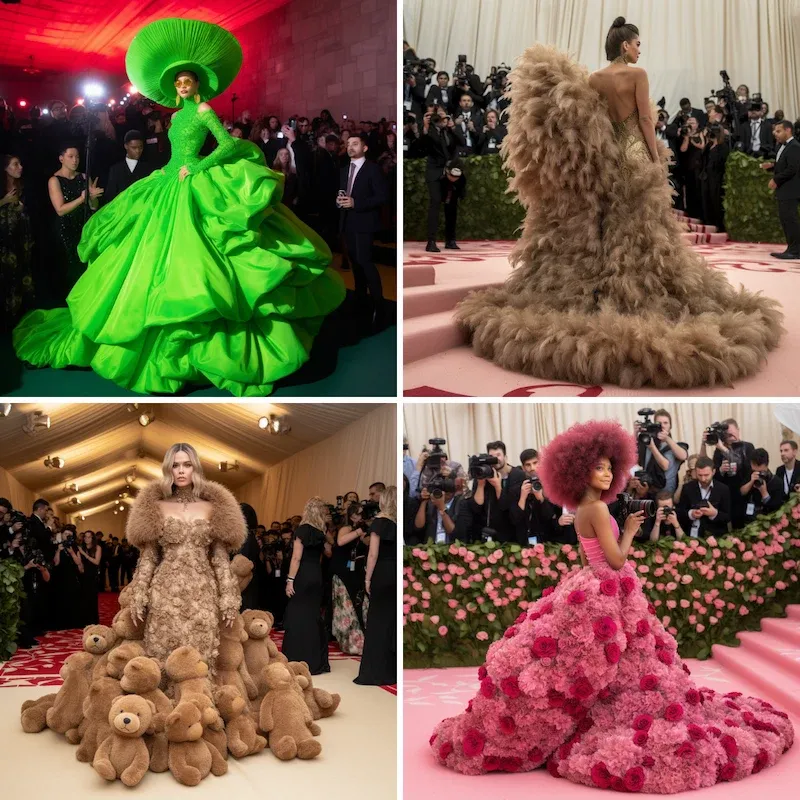
AI imagines Met Gala looks
What you should know about the 2023 Met Gala
The 2023 Met Gala is around the corner. We hope you’re ready to make a fashion statement!
In an attempt to boost revenue for the Metropolitan Museum of Art through New York’s high society, publicist Eleanor Lambert created the Met Gala in 1948. Today the Met Gala still occurs on the first Monday in May, marking the start of the most recent Costume Institute show. This year the late German-born designer, Karl Lagerfeld, will be honored for his iconic stylistic vocabulary with Karl Lagerfeld: A Line of Beauty.
With the Met Gala being such a fashion-forward event, we were curious, could AI technology outdress the pros? For this project, we used� MidJourney, a digital art AI system, to create realistic images from a description in natural language of styles from Met Gala themes over the past five years. Does AI do a good job at nailing the theme and coming up with looks? You be the judge!
2023: Karl Lagerfeld: A Line of Beauty
This year’s Met Gala theme will focus on Karl Lagerfeld’s work with prominent fashion houses such as Balmain, Chloé, Fendi, Chanel, and his namesake brand. In honor of the late designer, it would be appropriate for guests to wear any one of the following to dress to the theme:
- A pivotal look from one of the brands Lagerfeld founded
- Modern-day Chanel or Fendi (Lagerfeld left a remarkable impression on both houses)
- Clothes similar to Lagerfeld (including a Choupette, his famous cat)


So, how did it go?
We noticed that Midjourney could not develop as creative designs as Karl Lagerfeld himself.
We prompted the AI to incorporate Lagerfeld’s key styles, like tweed jackets, monochrome, and chic and sophisticated looks. Still, it was unable to add that iconic Lagerfeld touch. The images the AI gave us were realistic. We tried to keep it simple by imagining what it would look like if someone dressed like Lagerfeld themselves, wearing black sunglasses, high-collared white shirts, a tailored black suit, fingerless gloves, leather boots, and a variety of statement jewelry pieces. We also imagined people wearing the classic tweed suit that Lagerfeld created for Chanel, along with the gold accessories and black dresses seen in the 1990 Winter/Fall Chanel Fashion Show.
2022: In America: An Anthology of Fashion
The second section of the Metropolitan Museum’s investigation into American fashion was titled In America: An Anthology of Fashion. The inaugural examination, In America: A Lexicon of Fashion, had its debut in September 2021 and served as the inspiration for the Met Gala that year. Anthology served as a historical retrospective of both the designs and the biographies of their creators, in contrast to Lexicon, which offered a broad view of American fashion as a whole, with a focus on its younger designers.
This year’s dress code, Gilded Glamour, was inspired by the Gilded Age of New York from 1870 to 1890. The fashion during that period was one of excess. Due to innovations in electric and steam-powered looms, the fabric became faster and cheaper. As a result, women’s dresses often combined various textiles, such as satin, silk, velvet, and fringe, all adorned with over-the-top textures such as lace, bows, frills, and ruffles.


So, how did it go?
The AI images were creative yet extravagant and captured the essence of the Gilded Age of New York.
We asked AI to create popular dress silhouettes related to the Gilded Age period. Accessories such as hats with feathers were necessary during that time, and dresses were colored with deep jewel tones. Overall, the style during this time was extravagant, so we wanted our AI looks to resemble that.
2021: In America: A Lexicon of Fashion
This theme is part one of a two-part exhibition. Andrew Bolton, The Costume Institute’s Wendy Yu Curator in Charge, told Vogue he centered the 2021 event around the question, “who gets to be American?”, which was originally posed on a red, white, and blue silk sash from Prabal Gurung’s tenth-anniversary collection. The exhibition included over 100 pieces from American designers, ranging from Marc Jacobs to La Réunion. Guests, including co-chairs Timothée Chalamet, Billie Eilish, Amanda Gorman, and Naomi Osaka, abided by the night’s official dress code: American independence.


So, how did it go?
MidJourney did a solid job at creating a look that aligned with the description we gave it.
Since this theme paid homage to America, we decided to create a tribute to American icons throughout history. We asked AI to give us their interpretation of a Diana Ross-inspired dress. We also asked for an Old Hollywood-inspired look, and just for fun, we asked for a red, white, and blue look. One of the red, white, and blue looks is inspired by AI’s interpretation of Ralph Lauren’s classic style.
2020: About Time: Fashion and Duration (COVID)
Although the 2020 gala was postponed indefinitely due to the pandemic, its theme is still worth revisiting. This theme’s AI-generated designs represent what could’ve been.
With the Met celebrating its 150th year, About Time looked back at a century and a half of fashion. Andrew Bolton, a British museum curator, was inspired by the 1992 movie Orlando, adapted from the Virginia Woolf novel. The exhibition for the Met Costume Institute showcased fashion from the 1870s to the present day. It featured 60 garments and each garment represented a minute in time. Each minute (garment) represents how fashion is linear and connected in some way—whether through the fabrics, shape, material, or pattern.


So, how did it go?
For the most part, we observed that the AI created fashion-forward images, but lacked a connection between the two dresses.
The Met Costume Institute’s 2020 exhibition featured 60 all-black garments to showcase a silhouette and one white dress at the end to symbolize the future of fashion. We asked AI to create a futuristically styled look for the Met Gala red carpet. We also had it create black dresses with similar connections to showcase the theme’s point this year.
2019: Camp: Notes on Fashion
For 2019’s exhibition, Andrew Bolton drew on Susan Sontag’s seminal 1964 essay, “Notes on Camp.” The essay discusses an aesthetic “sensibility” characterized by excess, performance, and a winking bad taste exhibited by individuals like Oscar Wilde and wacky aesthetic trends like Art Nouveau. Stunning outfits by Off-White, Schiaparelli, Moschino, Dior, and Thom Browne, were among the ensembles on display.


So, how did it go?
MidJourney did a great job at capturing the over-the-top looks associated with the Camp theme.
We guided AI to create its rendition of Camp by asking it to create dresses made of teddy bears, feathers, oversized hats, and bold colors. MidJourney created its version based on the ideas of Camp. We thought the teddy bears were quite over-the-top and theatrical, poking fun at the traditional red carpet dress, which is what Camp means to do. The oversized feather dress represents the dramatic and costume aspects of Camp, and the green dress played into the idea of excess and boldness.
Methodology
We researched the Met Gala themes over the past five years to prompt AI to create digital art. We used various prompts and art style descriptions to generate Met Gala looks from AI. MidJourney is an AI system that can create realistic images and art from a report in natural language. We collected the best images for each theme to compare AI’s work to fashion designers.
Information about the Met Gala was gathered from Vogue and the Met Museum. The images generated were gathered from MidJourney. We collected this data in March 2023.
About us
BrightspeedPlans.com is an online authorized reseller of Brightspeed. For media inquiries, please contact .